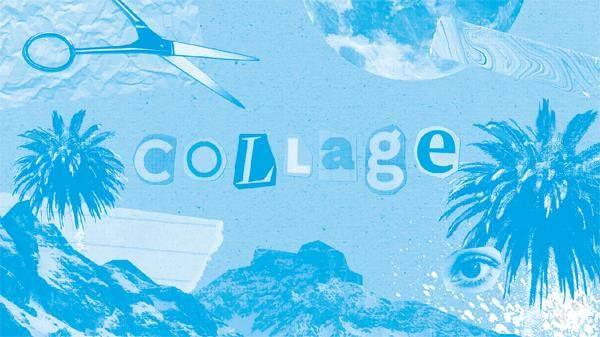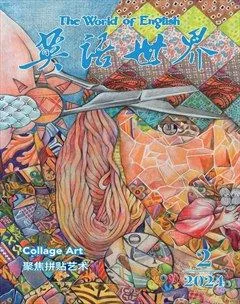Exploring the Evolution of Collage Art拼贴艺术演变史
凯莉·里奇曼–阿卜杜/文 施慧静/译

Throughout the 20th century, creatives across many movements, mediums, and styles began to explore the practice of collage art. The inventive and innovative approach to art attracted artists due to its one-of-a-kind aesthetic and unique, pieced-together process.
纵观整个20世纪,各路艺术家纷纷开始探索拼贴艺术——他们隶属多项艺术运动,创作媒介和艺术风格也多种多样。让他们着迷的正是拼贴独一无二的美感和与众不同的拼制过程带来的艺术创造性和创新性。
Beginning in the modernist period and continuing into the contemporary art world, the collage art form has undergone a series of changes as more and more artists opt to explore it. Here, we look at the cutting-edge history and ever-changing evolution of the craft, paying particular attention to the movements and artists that have shaped it.
随着越来越多的艺术家探索拼贴艺术,这门艺术从现代主义时期萌芽,一路发展到当代艺术的世界,经历了一系列的变化。在这里,让我们一起了解拼贴艺术的先锋岁月,跟随它日新月异的演变,重点关注影响拼贴艺术的流派和艺术家。
Collages can be created from a range of materials, though most are made of paper or wood and often feature cut-and-pasted photographs, painted forms, or even 3-dimensional objects. As more and more modern artists began exploring the practice throughout the 20th century, these mediums became more varied and increasingly experimental.
制作拼贴画的材料多样,但通常都是用纸张、木头来制作,以剪贴的照片、绘画,甚至三维立体的物品为主体。整个20世纪涌现出一大批探索这门艺术的现代艺术家,他们使用的媒介也变得更为多样,激发出更多实验精神。
History of collage art
拼贴艺术史
Precursors of Collage Art
拼贴艺术的先驱
The techniques associated with Collage Art were first used in China around 200 BC when paper was invented. The initial style of collage began to slowly come into fashion within 10th century Japan when calligraphers started to utilize glued paper and texts on surfaces when writing poetry.
纸张发明于公元前200年左右,早在那个时候,中国就已经出现了与拼贴艺术相关的技艺。最早的拼贴画风格在10世纪的日本逐渐流行起来,那里的书法家在写诗时,用涂上胶水的纸写字,贴到不同的地方。
Chinese pulp mills quickly spread to other parts of Asia, Africa, the Middle East and had arrived in Europe by the 11th century. Early adhesives such as Arabic skin glue were made from plant resins, animal bones, hides, and skins. The artistic technique of gluing to create images appeared in the 13th century medieval. The image of St. Dorothea (c. 1450—1500 CE) shows that the trees, border, and St. Dorothea’s dress were decorated with crystals and tinsel.
中國的纸浆厂很快传遍亚洲、非洲和中东地区,在11世纪传到欧洲。早期的胶水,比如阿拉伯皮胶,是由植物树脂、动物骨头、兽皮制成的。中世纪13世纪出现了利用胶水粘贴制作图像的技艺。在圣女多罗德(公元1450—1500年)的画像中,树木、饰边,还有圣女的衣裙都用水晶和金属箔点缀。
By the 15th and 16th centuries, religious images in manuscripts, gothic cathedrals, and noble Coats of Arms were commonly adorned with gold leaf, gemstones, and other precious items. Paper collage art forms such as silhouette became popular in the 19th century as domestic novelties that would have been affordable and accessible to a wider range of people.
到了15至16世纪,手抄本中的宗教图像、哥德式大教堂和贵族盾徽常常以金叶、宝石和其他贵重物件装饰。剪影一类的纸制拼画在19世纪成为流行的家居装饰,更多的人买得起、会制作。
Collage was also seen as a method of art undertaken by hobbyists for a period of time, as this style was used in items of memorabilia, such as photo albums, and books within the 19th century. However, many institutions have attributed the history of collage and its official beginning within the art sphere to be dated around 1912, when both Picasso and Braque began to experiment with this style in their artworks.
拼贴画有一段时期也被视作业余爱好者的一门艺术:在19世纪,拼贴被用于制作相册或书籍一类的纪念物。不过,各个艺术机构将拼贴历史及其最初正式归入艺术领域的时间定为1912年左右,因为在这一年,毕加索和布拉克不约而同在作品中尝试拼贴。
Cubism
立体主义
In the early 20th century, collage came to the forefront of modern art. It solidified its place in fine art around 1912 when it coalesced with art movements such as Cubism, Constructivism, and Futurism. While Cubism is most often associated with painting, its founding figures, Georges Braque and Pablo Picasso, also created collages in this style. Defined by fractured forms and deconstructed subject matter, Cubism paired perfectly with the collage approach, as it enabled artists to literally piece together a picture from dissimilar components.
到20世紀初,拼贴画逐渐走到了现代艺术的前沿。1912年左右,拼贴画与立体主义、构成主义以及未来主义融合,从而在高雅艺术领域取得一席之地。尽管立体主义主要以绘画为表现形式,但立体主义的奠基人乔治·布拉克和巴勃罗·毕加索都创作过立体主义的拼贴作品。立体主义本身就靠破碎的图形和解构内容来定义,因此与拼贴艺术相得益彰,它让艺术家通过剪贴截然不同的构件完成画作。
Additionally, unlike painting, collages did not risk appearing flat. This fact, according to esteemed art critic Clement Greenberg, was appealing to artists like Picasso and Braque, who focused on evoking dimensionality in their work. “Flatness had not only invaded but was threatening to swamp the Cubist picture,” Greenberg explained in a 1958 issue of Art and Culture.
而且,拼贴画也不像绘画那样囿于平面。知名艺术评论家克莱门特·格林伯格认为,拼贴深深吸引了像毕加索和布拉克这样的艺术家,是因为他们的作品重视立体感。“平面感不只是对立体主义的侵犯,甚至可能让立体主义的阵地沦陷。”格林伯格解释说,此话刊载于1958年的《艺术与文化》。
In addition to painted paper cut-outs, newsprint, and patterned paper were often employed by Cubists, as evident in Picasso’s Bottle of Vieux Marc, Glass, Guitar and Newspaper, and Braque’s Violin and Pipe.
除了绘画剪纸之外,立体主义画家还曾使用新闻纸和印有花样的纸张,以毕加索的作品《酒瓶、玻璃杯、吉他和报纸》和布拉克的作品《小提琴和烟斗》为代表。
Dada
达达主义
Dada, which began in 1916 in Zürich, Switzerland, was especially suited to the collage art form. Unlike the Cubists, who favored still-life arrangements, the Dadaists created collages that incorporated a wide array of iconography, from reinterpreted portraits to figures rooted in fantasy.
达达主义运动在1916年始于瑞士苏黎世,与拼贴艺术是绝配。达达主义有别于偏爱静物排列的立体主义,利用各式各样的图像材料创作拼贴画,从重新诠释的画像到幻想人物,应有尽有。
Dada artists also creatively incorpor- ated more materials into their collages than their Cubist counterparts. Members of the movement are particularly renowned for their innovative use of seemingly worthless or often overlooked items like tickets, magazine and newspaper clippings, candy wrappers, and even 3-dimensional trinkets1. By transforming ephemera2 into polished pieces, the Dadaists challenged traditional perceptions of art.
比起立体主义的同行来,达达主义的艺术家更富创意,他们把更多材料活用到拼贴画中。达达主义流派擅长利用日常遭到忽视,甚至人们弃若敝屣的物件创作,比如车票、杂志报纸的剪报、糖纸,还有三维的小装饰品。达达主义艺术家就是让短时效物品摇身变成精美艺术品,挑战了传统的艺术观念。
Surrealism
超现实主义
On the heels of Dada, Surrealists adopted and adapted this cut-and-paste technique. Much like their “automatic” approach to painting, these artists relied on the subconscious to produce one-of-a-kind assemblages made of photographs, illustrations, pieces of paper, and paint.
紧随达达主义脚步而来的是超现实主义画派,他们采用并改良了拼贴技艺。艺术家把“无意识”的绘画方式沿用到了拼贴上,发掘自己的潜意识,利用照片、插图、纸张和颜料制作独一无二的拼合艺术品。
Abandoning the Cubists’ focus on still life, they embraced and expanded upon the Dadaists’ move toward strange subject matter to create pieces evocative3 of a dream. This focus is exceptionally evident in the work of Joseph Cornell and André Breton, who both used the method as a means to conjure up cohesive yet entirely made-up scenes.
超现实主义艺术家摒弃了立体主义对于静物的专注,接受并拓展了达达主义对稀奇古怪素材的追求,创作出幻梦色彩的作品。其中的佼佼者有约瑟夫·康奈尔与安德烈·布雷顿,他们的作品用拼贴手法,像魔术师一样变幻出紧密衔接却纯属拼凑起来的场景。
Abstract Expressionism
抽象表现主义
Like the early modern artists that preceded them, Abstract Expressionists challenged conventional ideas about art. In order to take this avant-garde stance a step further, they rejected figurative subject matter and worked entirely in the abstract. This approach, however, was not limited to their more well-known drip, color field, and soak stain paintings; it is also evident in their collages.
抽象表现派艺术家与早先的现代派艺术家一样,勇于挑战传统的艺术观念。他们脱离具象题材,全然投身于抽象作品的创作,把这一先锋态度推到了新的境界。抽象表现主义不仅用于他们更著名的墨迹点滴、色域绘画和浸泡染色作品,在他们的拼贴画中也显而易见。
Like their paintings, Abstract Expressionists’ collages showcase an emphasis on color, composition, and emotion. Through simplified silhouettes, blocks of cut-and-glued color, and free-floating painted lines, the artists added (literal) layers of dimensionality to their already-famous aesthetic.
抽象表现主义的拼贴画和绘画作品一样,浓墨重彩地展示色彩、构图和情绪。透过简单勾勒的剪影、大块的色彩剪贴、自由的色彩线条,艺术家在大众熟知的艺术美感中加入(实实在在的)一层层立体感。
Pop Art
波普艺术
In 1956, British artist Richard Hamilton ushered in the Pop Art movement with his eye-catching collage, Just what is it that makes today’s homes so different, so appealing? Featuring carefully-selected clippings from American magazines, this piece incorporates several contemporaneous4, pop culture-related everyday motifs, including “Man, Woman, Food, History, Newspapers, Cinema, Domestic Appliances, Cars, Space, Comics, TV, Telephone, Information.”
1956年,英國艺术家理查德·汉密尔顿首开波普艺术的先河,他推出备受瞩目的拼贴画《到底是什么让今天的家如此不同,如此吸引人?》。作品采用了精心摘选的美国杂志剪报,纳入若干在当时与流行文化相关的日常主题,包括“男人、女人、食物、历史、报纸、电影、家电、汽车、太空、连环画、电视、电话和信息”。
In addition to setting the scene5 for Pop Art in terms of subject matter, this piece also inspired other members of the movement to explore collage art.
该作品不但为波普艺术选择主题创造了条件,也启发了其他波普艺术家探索拼贴艺术。
(译者为“《英语世界》杯”翻译大赛获奖者;单位:上海工程技术大学)

